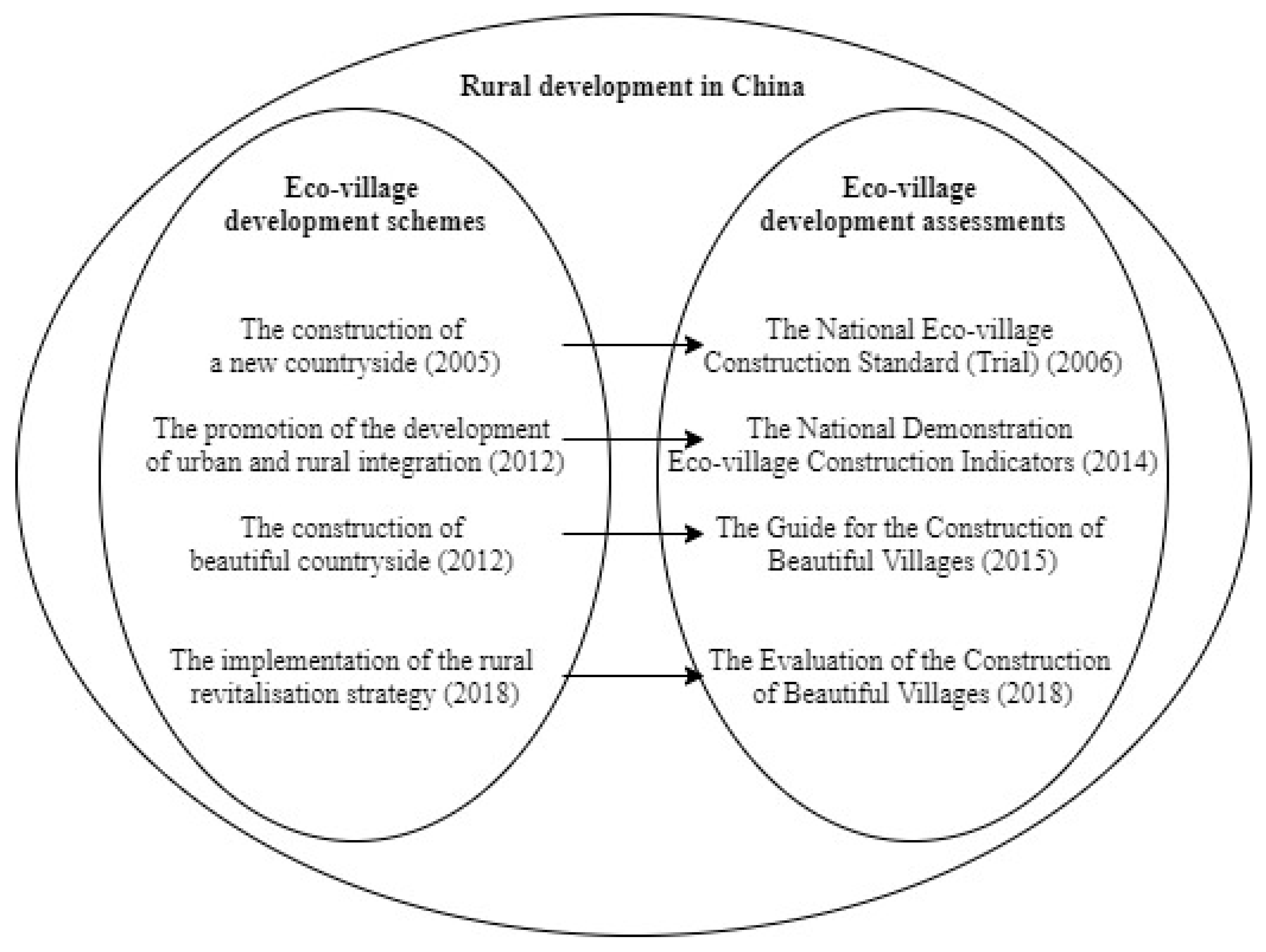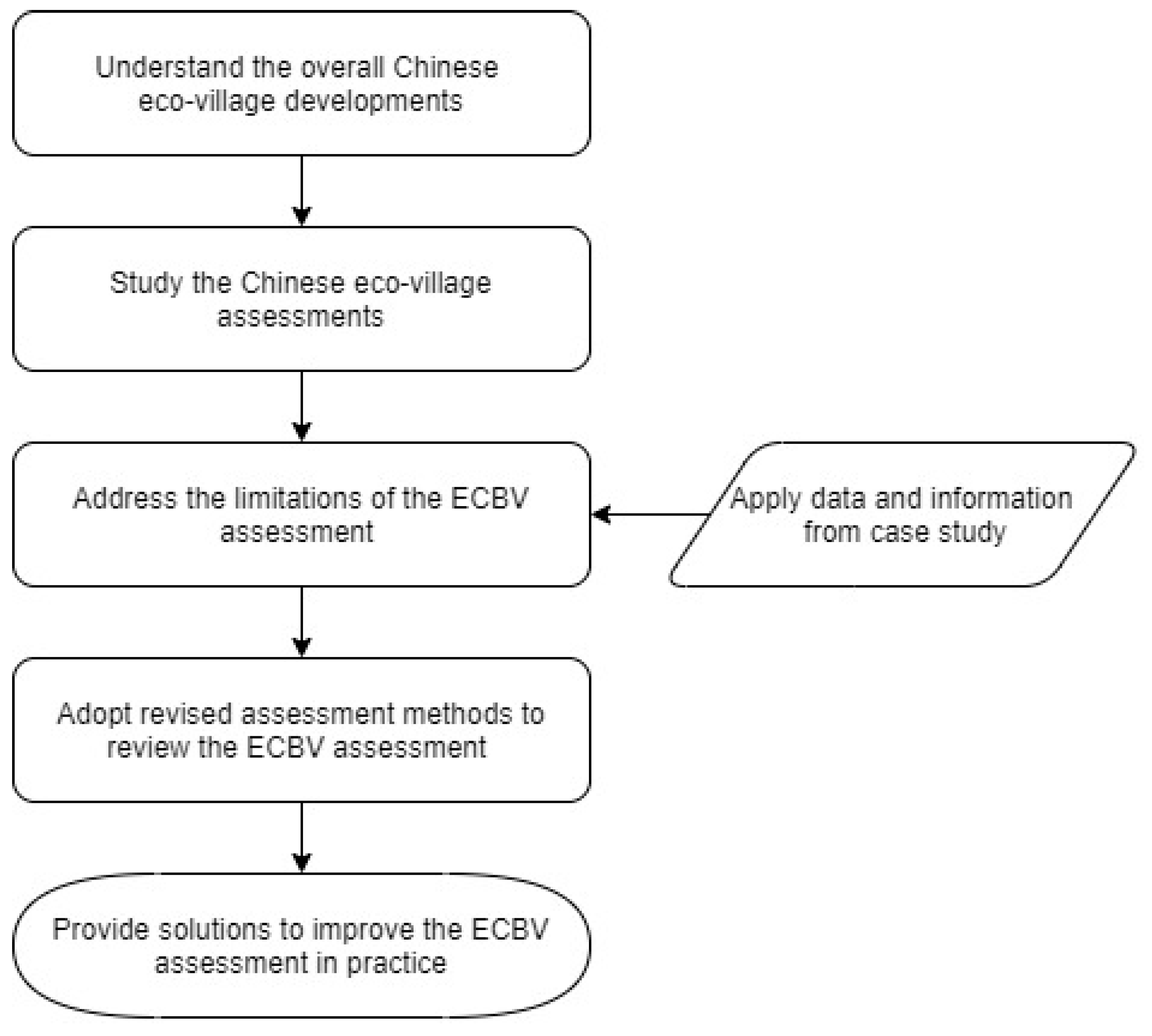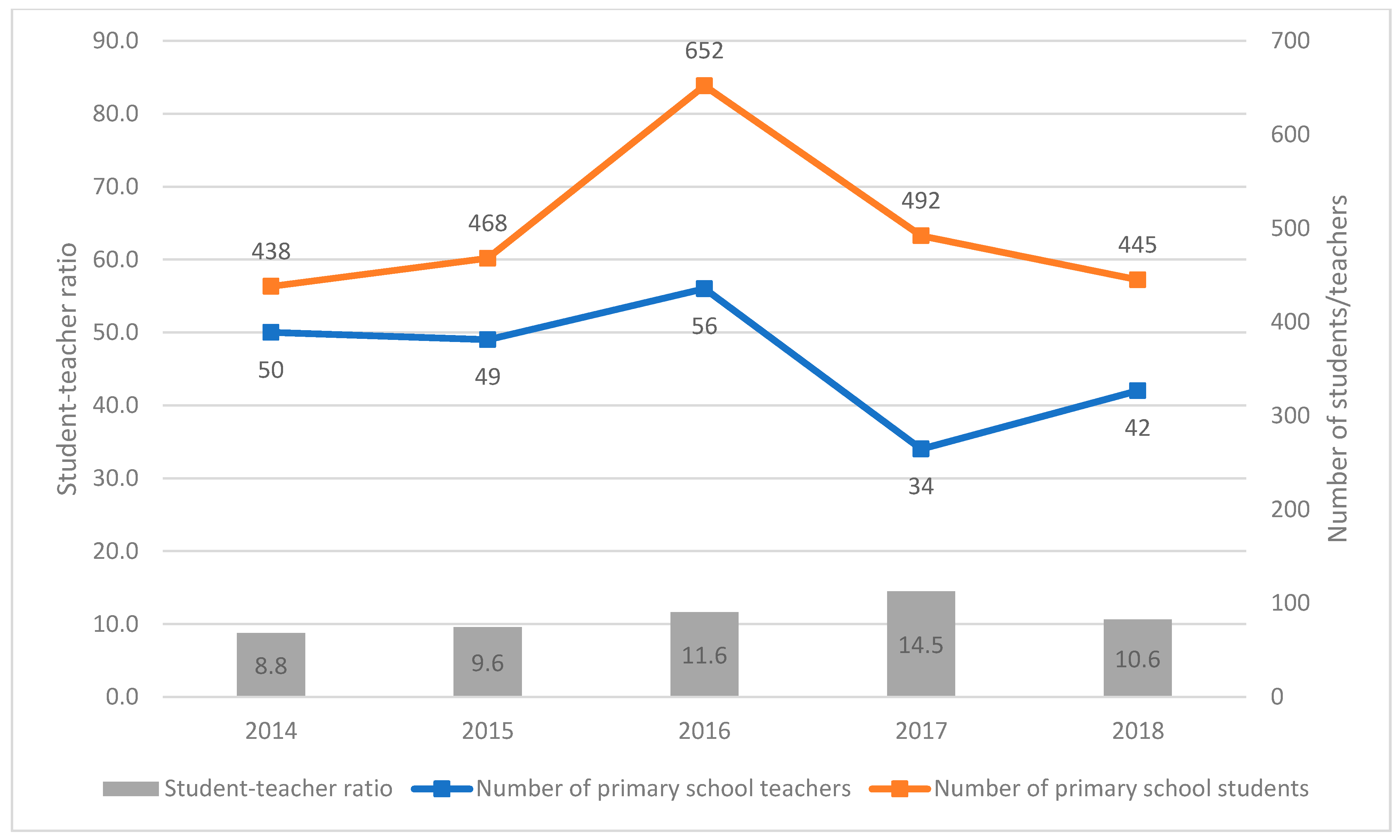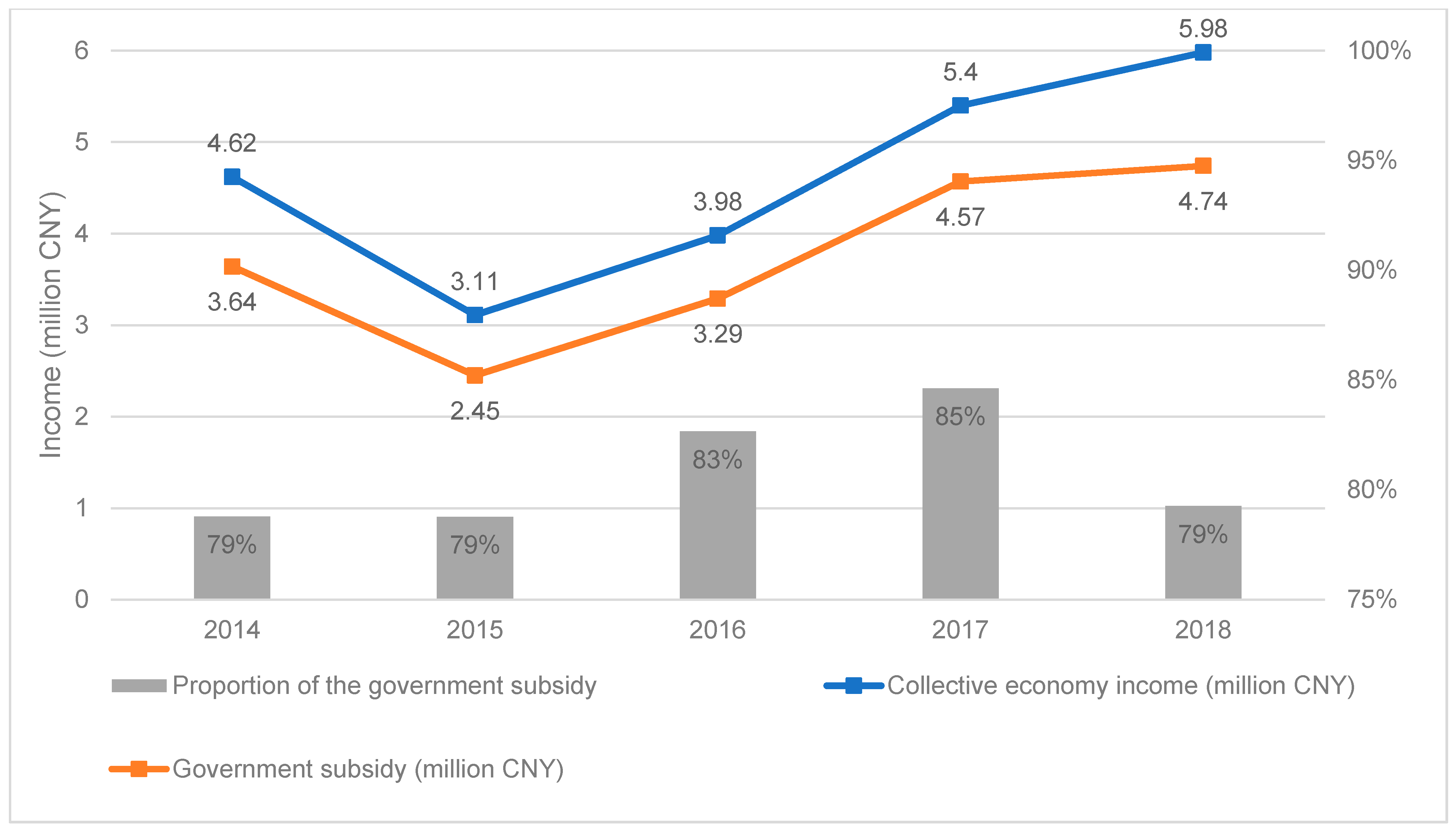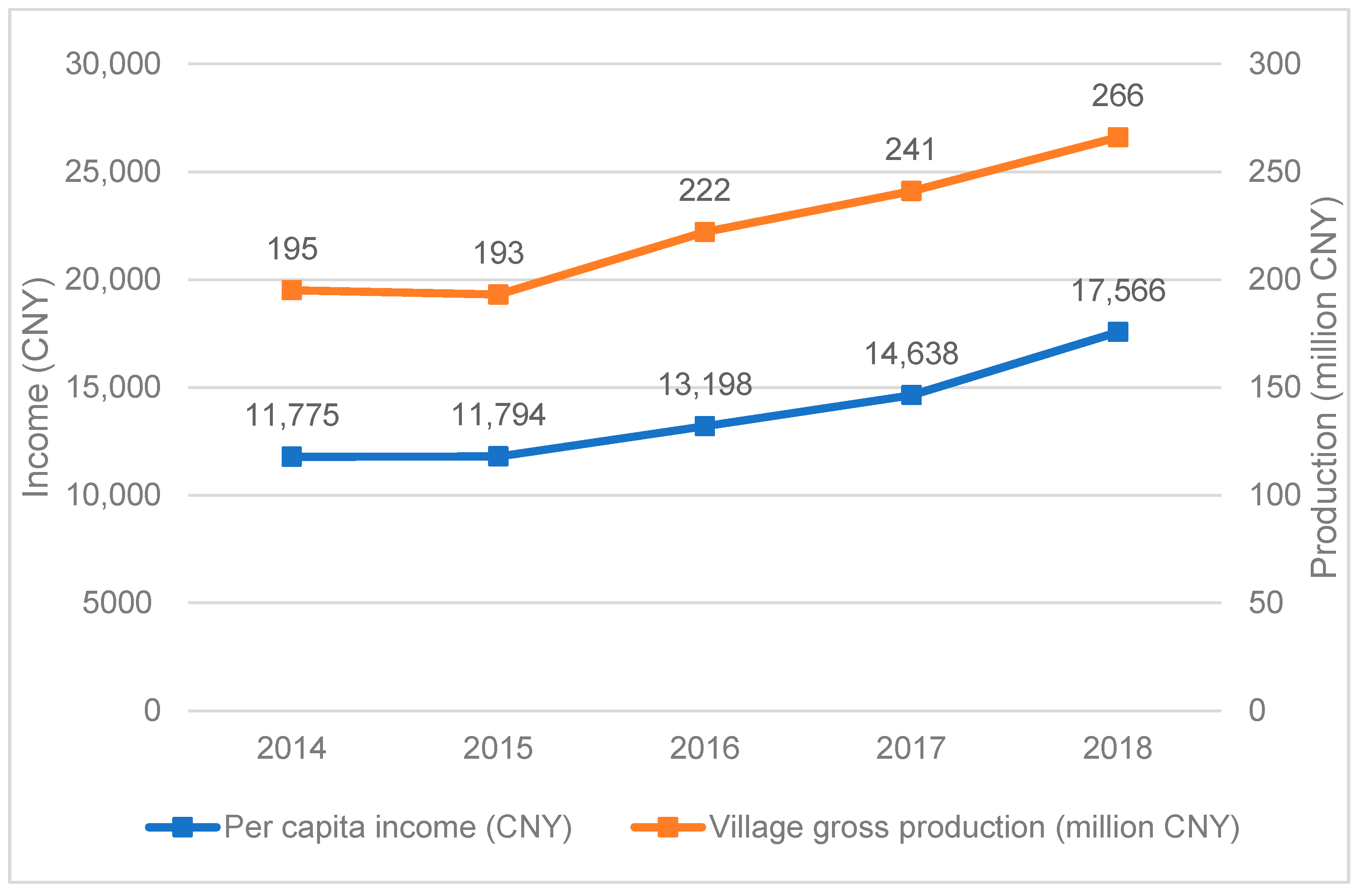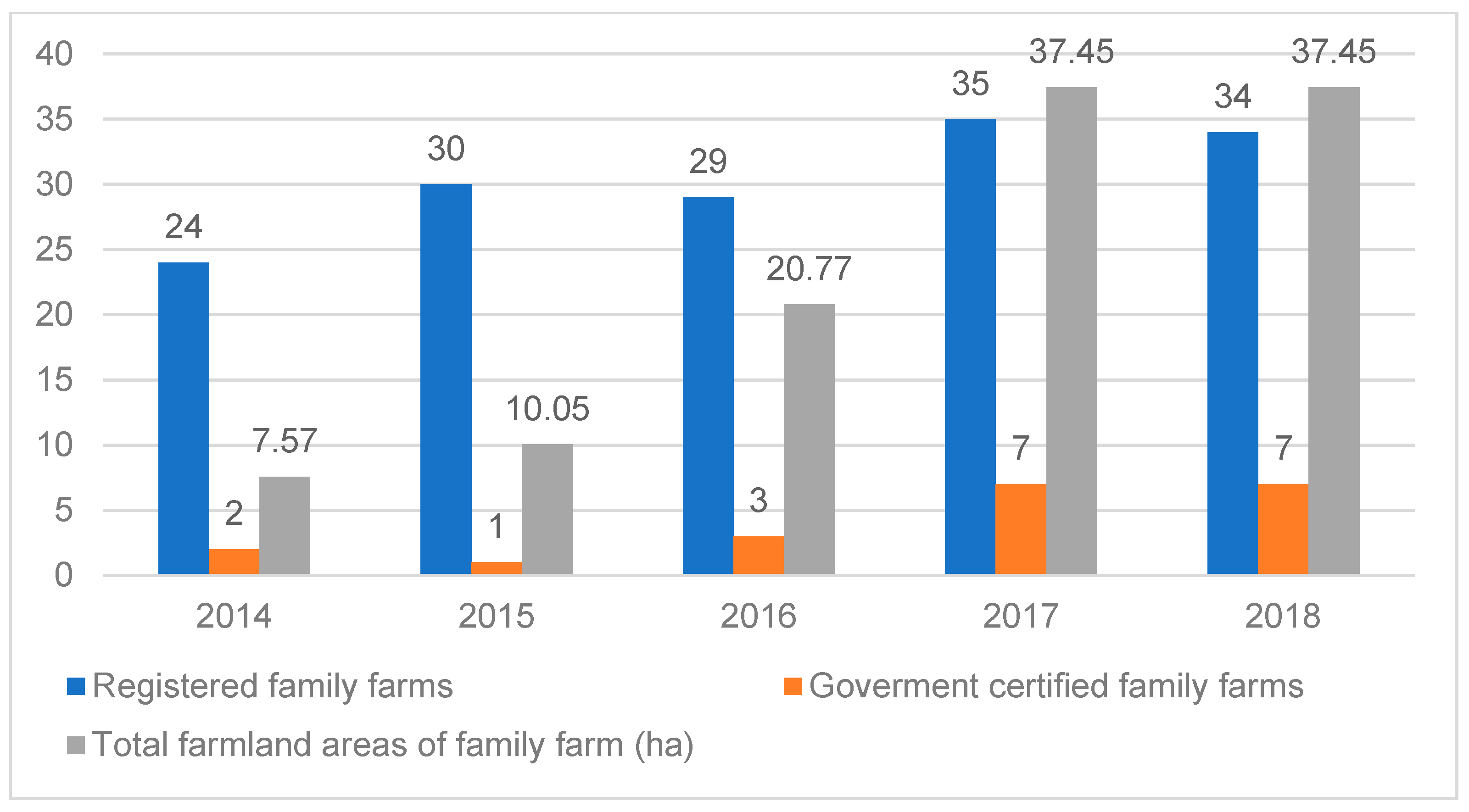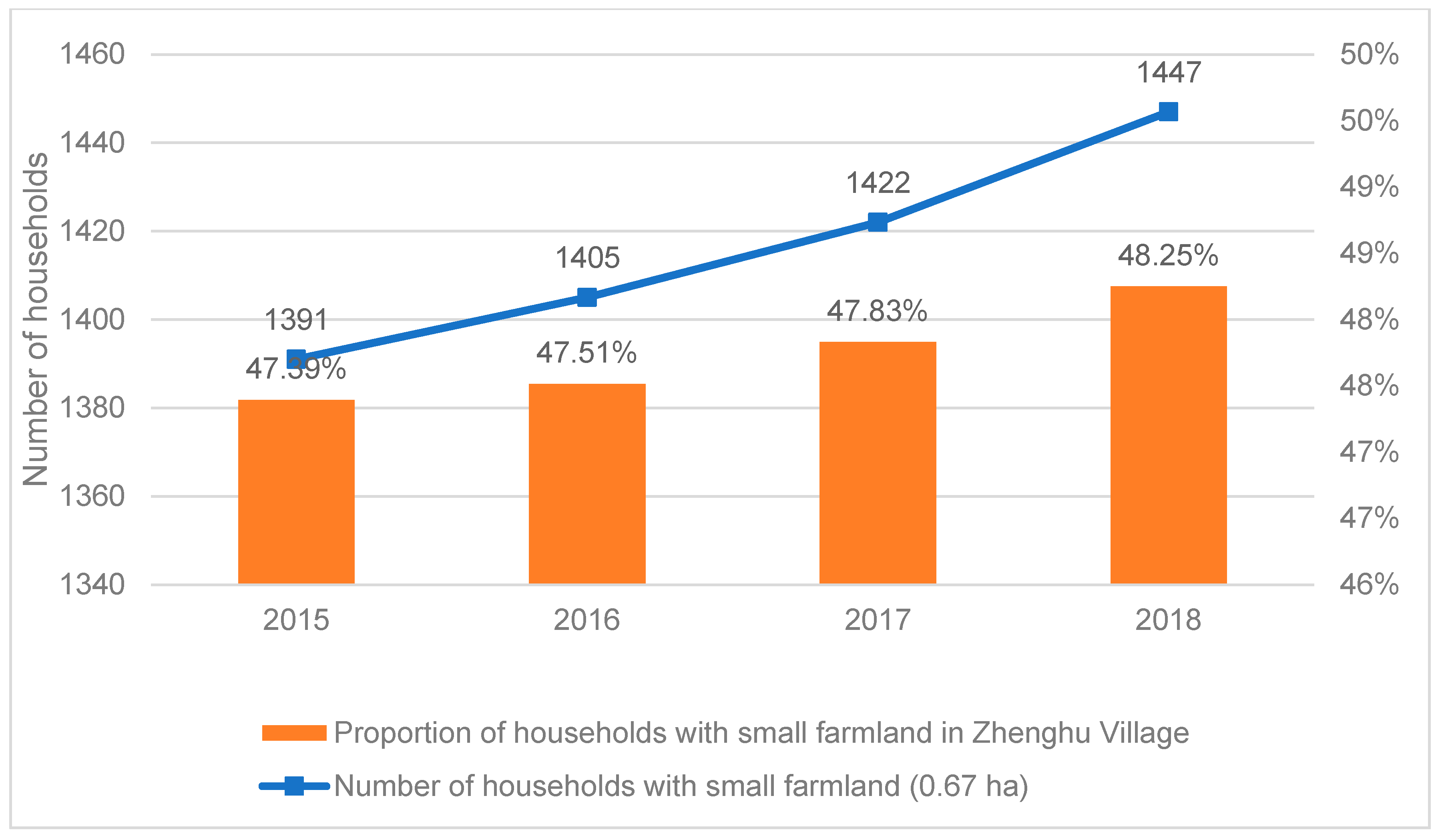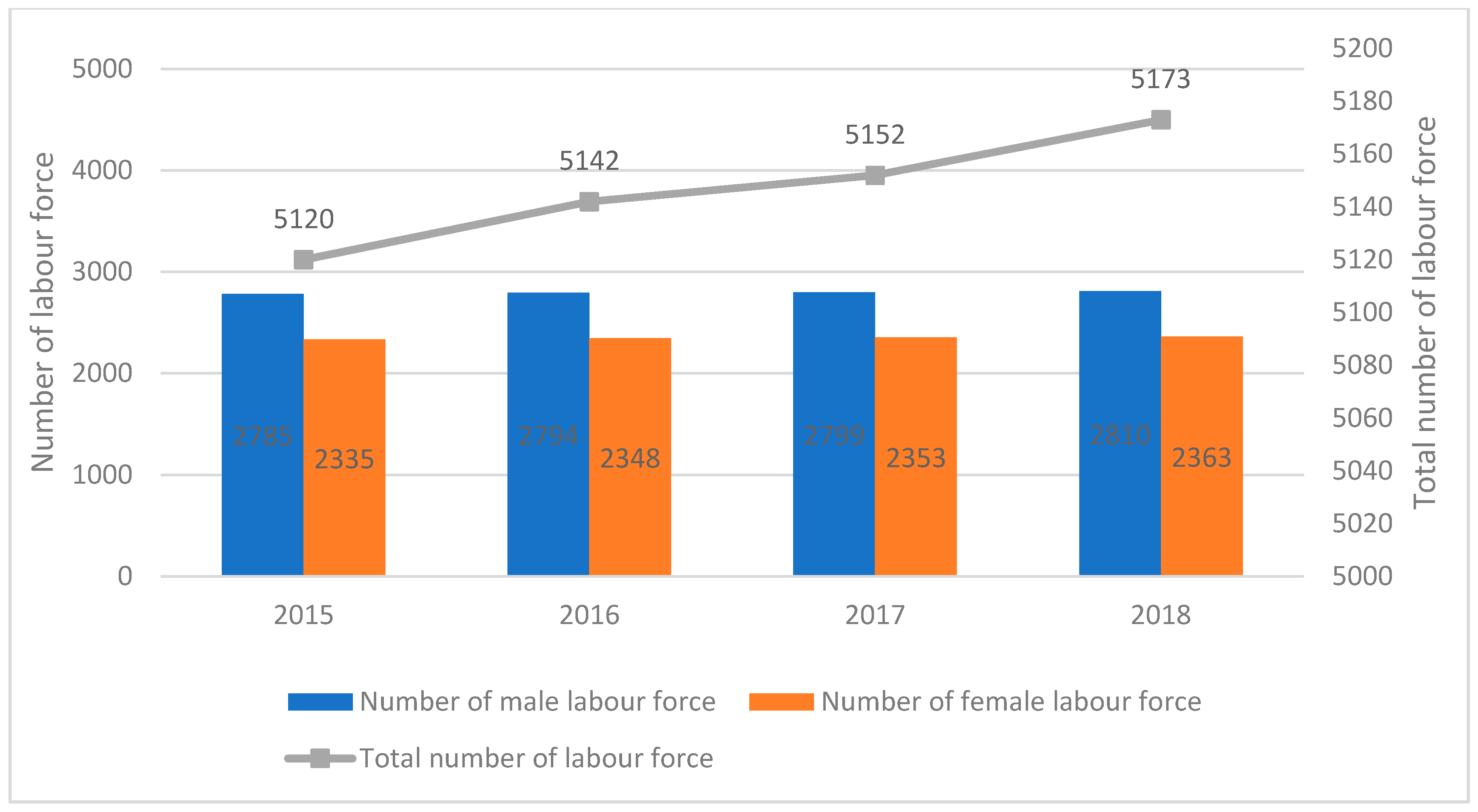1. Introduction
Recent studies have revealed that worldwide urbanisation has caused some adverse effects on the social, economic, and environmental aspects of rural development, including “rural hollowing” as the workforce leave rural areas in order to achieve a better standard of living in urban areas [
1,
2], the skewing of the population towards the elderly and children [
3,
4], and farmland abandonment [
5,
6]. Many developed countries have started the transition in rural areas to cope with these negative facets of rapid urbanisation processes for decades [
7,
8,
9]. These issues have also been recognised in China and in other developing Asian countries, which have led to extra economic and social pressures such as housing affordability in urban areas [
10,
11,
12].
To solve these rural issues as a matter of urgency in China, the central government learned from other Asian countries, including Japan and Korea, which had experienced urbanisation earlier than China [
13]. One of the adopted solutions is to develop the rural area in a sustainable way that can regenerate social and natural environments and integrate cultural and economic dimensions in a long-term process [
14,
15]. The ultimate goal of rural development is considered to be achieving social, economic, and environmental sustainability [
16,
17,
18]. Therefore, the Chinese government has launched a series of campaigns, from issuing policies and legislation to providing incentives and funding, to support sustainable development in rural areas [
19]. As a result of this initiative, a series of nationwide eco-development schemes have been introduced since 2005 [
20]. In 2008, the Chinese government identified the eco-village development proposed in the ‘Beautiful Village’ scheme as one of the most effective and efficient schemes to solve rural issues due to its positive effect on retaining young villagers [
21]. Therefore, developing eco-villages became one of the leading measures for solving rural issues. After recognising eco-village development as a holistic approach to integrating the cultural and economic dimensions, and regenerating the social and natural environments [
14,
22], the Chinese government began massively facilitating eco-village development in rural areas. According to the official Chinese rural revitalisation strategies, there are various measures to develop rural areas, including the development of eco-villages, acceleration of the agricultural modernisation, promotion of the rural industries, and improvement of the urban-rural integration [
23]. In addition to the rural development policies, recent studies have also indicated that the principles of eco-village development are consistent with the strategies of the rural revitalisation campaign in China, which was formulated to develop rural areas equally in their economic, social, and environmental aspects, and to reduce urban bias [
19,
24,
25].
To ensure that rural issues are resolved by developing eco-villages practically, the Chinese government has established a range of corresponding assessments: the National Eco-village Construction Standard (Trial) [
26], the National Demonstration Eco-village Construction Indicators [
27], and the Guide for the Construction of Beautiful Villages [
28]. These assessments were the trial versions, and they constituted the early efforts to regulate and assess eco-village development in China. However, these early versions of Chinese eco-village assessments had some limitations, such as unbalanced criteria, limited indicators, and a complicated assessment process [
19,
29]. Thus, Chinese researchers have highlighted that assessing an eco-village is as essential as building it, and they have suggested formulating a specific assessment to comprehensively assess sustainability performance [
30,
31].
In this context, the latest Chinese eco-village assessment, the Evaluation for the Construction of Beautiful Villages (ECBV), was formulated at the end of 2018 [
32]. This assessment is an extension of the relevant national guide published in 2015. When compared to the first two eco-village assessments published in 2006 and 2014, it is clear that ECBV covers multiple assessment aspects and is the most comprehensive of the four (
Figure 1). However, it still has some limitations in terms of the assessment method, criteria, and indicators, especially their applicability when evaluating various eco-village cases in China [
33]. Thus, the ECBV assessment needs to be revised by introducing new features. This paper aims to identify the limitations of the current Chinese eco-village assessment, ECBV, and to propose solutions. The solutions were developed by applying a revised assessment approach developed in a previous study [
29] to a carefully selected development case and analysing each of the assessment aspects. The case study results from Zhenghu Village will be presented in
Section 4. By analysing the collected data and information, the limitations of the current Chinese eco-village ECBV will be revealed, and the corresponding solutions will be presented.
3. Methodology
In this paper, a case study was conducted to address the limitations of the ECBV in practice. This research method can reveal the limitations practically by presenting the inadequate assessment process and results. Hence, Zhenghu Village, a typical eco-village development located in Fujian, China, was selected as the eco-village development case to be studied. In the case study, the ECBV assessment method was applied to evaluate the data collected from the previous ethnographic study. After addressing the limitations of the ECBV, the corresponding solutions to improve the assessment were found by adopting revised assessment methods from SDIs. The framework of the study methodology is shown in
Figure 2.
3.1. Case Study: Zhenghu Village
Zhenghu Village was one of the traditional villages that suffered from the rural issues mentioned earlier in terms of economic, environmental, and social aspects. It was a mountainous village located in South China with very limited area for growing crops (
Figure 3). Stricken by poverty, the village was losing its labour force, as the young and capable villagers were leaving for job opportunities in cities and other regions. This resulted in rural hollowing and farmland degradation in Zhenghu Village. In the 2000s, through an initial nationwide eco-development campaign, an eco-village development scheme was conducted in Zhenghu Village. In 2012, the village was certified by an assessment panel using an early version of the Chinese eco-village assessment, the National Eco-village Construction Standard (Trial) [
26]. However, the trial version with only fifteen indicators proved to be too general and inadequate to assess Chinese eco-villages [
50]. Two years later, Zhenghu Village was recognised as a demonstration project of eco-village development in China. It became a typical case in the eco-village development scheme, according not only to its size and population, but also to its development history, as the villagers pulled themselves out of poverty and successfully transformed their village into a government-recognised eco-village.
In 2009, after three-year continuous investment in infrastructure and agricultural industries, the rural plan was implemented (
Figure 3b) [
51]. The local government believed that the eco-village development scheme helped to solve rural issues as the villagers’ standard of living improved significantly, a phenomenon echoed in studies in developed countries [
7,
52]. The regular inspections of eco-village development also confirmed the achievements made in Zhenghu Village throughout the last decade. It can be seen from the government’s annual reports that the data on the social, economic, and environmental aspects of the village, including permanent residents, individual income, and medical insurance coverage, met the requirements in the ECBV.
However, even if all the requirements were met during the assessment, this does not mean that the development in Zhenghu Village will continue moving in the right direction with effective and efficient strategies. For example, over 90% of the villagers were covered by basic medical insurance from 2014 to 2018, which exceeded the baseline required in the ECBV indicator of basic medical insurance coverage. However, the relevant assessment criteria in ECBV were eased according to the general rural development level in China. It was a requirement that basic medical insurance should cover all the villagers in Zhenghu, but in 2018, the percentage covered still only reached 92.35%. Besides, the local government considered that developing agriculture was essential for alleviating poverty, so they continuously invested in agricultural industries to boost economic development. This measure benefited the local economy at first, but it brought other negative consequences, including misleading income data and a lack of diversification in the local economy. These two problems will be analysed in detail in
Section 4, along with other ECBV assessment limitations.
3.2. Mixed Methods
The primary purpose of developing eco-villages in China is to solve the increasingly serious rural issues. Under the circumstances of rapid urbanisation in China, the rural issues mentioned above can be solved with continuous eco-village development in rural areas. To investigate rural development in China, both qualitative and quantitative methods should be used, and this type of mixed-method approach is increasingly popular in rural studies. In recent research, Strijker et al. [
53] concluded that the rural study context provides considerable scope for an extensive application of mixed methods, which exactly corresponds with this study context. Thus, for the data collection and the analysis, both qualitative and quantitative methods were adopted in this study to address the limitations of Chinese eco-village assessment and to propose solutions to improve it.
In order to address the limitations of the ECBV in practice, a case study of a typical Chinese eco-village development, Zhenghu Village, was conducted. The data required to repeat the assessment process were collected from interviews, documents, and observations, which will be explained in
Section 3.3 in more detail. With the exploratory sequential research method, the study starts with qualitative research and then analyses the subsequent quantitative components [
54]. Therefore, the data will be rearranged to show the development trends and notable changes during the eco-village transition in Zhenghu Village.
As an ongoing process, eco-village development cannot be achieved all at once; therefore, this type of development needs to be assessed in the long term. However, even if an eco-village’s status is inspected regularly in China, the ECBV assessment applied during the inspection can only assess sustainability through the data collected that year. Moreover, the unbalanced assessment criteria and missing indicators in the ECBV have been highlighted in recent research [
55]. The ECBV therefore needs to be revised in order to improve the assessment method.
The assessment method proposed here to improve the ECBV is drawn from the SDIs [
49], which use a long-term tracking assessment method and employ qualitative analysis. Furthermore, the SDIs implement headline and supplementary indicators to measure the primary and particular sustainability performances for the whole country. In a word, SDIs provides an overview of the long-term progress made on the aspects of social, economic, and environmental development nationwide. However, the SDIs assessment method cannot be adopted directly for eco-villages due to its assessment scope and scale—the volume and complexity of an eco-village development in China are significantly smaller than those of a country. Furthermore, the ECBV assessment is designed according to the national conditions in China, and it focuses on solving rural issues by assessing 101 indicators. Therefore, the SDIs assessment concepts, including quantitative analysis of the development trends, qualitative analysis of the reason and impact of the trends and changes, and indicators of supplementary evidence, will be applied to the case study results.
3.3. Data Collection and Analysis Methods
In order to address the ECBV assessment limitations in practice, the data analysed in this study were collected from government annual reports, two open-ended surveys among villagers, interviews of government officials, local media, and direct observations. The government reports, including government work reports, demographic data, and the development schemes for the local economy, provide comprehensive and authentic annual data for the eco-village development in Zhenghu Village. All these documents show the social, economic, and environmental development from 2000 to 2019 through reliable and accurate statistics. Apart from the governmental primary data, other sets of data on the development history of Zhenghu Village, including the masterplan of public facilities, were used. These sets of data are proven to be reliable because they have been used in previous research, and they can confirm the materials collected from the government reports and local media. In the case study, all these collected data and information are rearranged and visualised in a series of figures to explicitly address the limitations of the ECBV assessment.
4. Case Study Results and Analyses
As mentioned above, the data for eco-village development in Zhenghu Village were collected during previous fieldwork from various resources. In this section, considering accessibility and confidentiality, the most relevant and typical data, according to the Chinese eco-village development assessment, are rearranged and analysed here.
4.1. Limitations of the Static Assessment Process
The demographic statistics (
Figure 4a) reveal that the rural population in Zhenghu Village generally remained at the same level (average decline 1.2% each year). Against the overall rural population decrease in China during the same period (
Figure 4b), eco-village development exerted a tremendous influence by solving the rural hollowing issue. However, efforts to maintain the rural population during times of rapid urbanisation cannot be assessed through the ECBV as it only assesses the current number of permanent residents each year, rather than over a longer period of time. Thus, the ECBV assessment cannot reveal the fundamental relationship between eco-village development during the rural revitalisation campaign and population shifts.
In the social welfare aspect of the ECBV, the percentage of villagers covered by medical insurance is a mandatory indicator that has to be greater than or equal to 90% to pass the assessment.
Figure 5 shows that the rate was always over 90% from 2014 to 2018, which secured eco-village recognition for Zhenghu Village. On the other hand, while the total number of insured people increased steadily, the percentage covered by medical insurance fluctuated, due to population shifts, rural medical insurance system reform, and government support. However, according to the official statistics, national medical insurance covered over 95% of the total population [
57]. Thus, the coverage in Zhenghu Village was still far below the nationwide average. Moreover, even though Zhenghu Village passed the assessment of medical insurance-related indicators each year, and the number of insured people was increasing, the annual change in the percentage of people not covered by medical insurance cannot be reflected through the ECBV assessment. This defect in the assessment prompts eco-village developments to pursue a good score during the assessment process instead of focusing more on development progress, which makes the ECBV assessment a formality.
A similar situation also happened with the education-related assessment. The ECBV indicators mainly focus on compulsory education coverage in each year. However, the student–teacher ratio and the number of students and teachers were not assessed individually during the period 2014–2018, despite the fact that they could indicate the allocation of educational resources in Zhenghu Village. Compared to the standard, the unaddressed student–teacher ratio was much better than in many traditional villages [
58]. More unaddressed indicators will be discussed in
Section 4.3.
Despite satisfying the education-related assessment in ECBV, the series of data presented in
Figure 6, showing large changes, could not be assessed or further analysed by the evaluation process at that time. In this case, the ECBV assessment results cannot evaluate in detail a section that needs to be strengthened as many of the potential improvements are hidden behind recognition. Moreover, the same problem of ignoring sustainability development trends on a year-on-year basis also exists in the economic and environmental assessments.
4.2. Limitations of the Absolute Grading
Apart from considering an eco-village’s development trend, the ECBV assessment also needs to have more comprehensive qualitative assessment criteria. The electricity consumption during 2015–2017 is a typical example of assessment data that can cause misunderstanding of the degree of eco-village development.
Although Zhenghu Village passed the energy consumption assessment for eco-village development, this does not mean that the energy strategy was appropriate at that time. As for electricity consumption from 2015 to 2017, the total and average consumption in Zhenghu Village were increasing significantly. However, the average electricity consumption (presented in
Figure 7) was still much lower than the national per capita consumption of 4616 kWh in 2017 [
59]. The increase in energy consumption mainly resulted from the mechanisation of agricultural production and the promotion of home appliances in Zhenghu Village, both of which were sponsored by the local government. In this case, the year-on-year growth in electricity consumption marked an improvement in living standards instead of a low energy efficiency scenario represented by the absolute grading results.
Government support is helpful for improving rural living standards. However, it is not always beneficial for eco-village development in China. One of the typical examples is that financial support is counted as annual income in Zhenghu Village.
In Zhenghu Village, the collective economy has grown to be one of the crucial parts of eco-village development. The annual collective economy income consists of earnings from government subsidies, operations, subcontracts, investments, and others. As the local government usually designs and develops eco-villages in traditional villages, the government financial support, which is classified as one of the collective economy incomes, was provided at the development’s initial stage [
60]. However, it can be seen from
Figure 8 that the annual government subsidy still accounted for over 80% of income after Zhenghu Village was certified as an eco-village in 2012. In this case, with such a large portion of government funding, the “favourable” assessment results can neither prove economic growth nor drive further development through the current grading system in the ECBV.
Moreover, this misleading assessment result could lead to a poor industrial structure through misunderstandings of the trends in income growth in the annual collective economy. Zhenghu Village is confronted with this problem due to a lack of motivation and necessity to diversify its industries. In this case, more qualitative analyses should be introduced into the ECBV so that it can assess eco-village sustainability more thoroughly.
4.3. Limitations of the Unaddressed Indicators
Government support, especially financial support, was not only concentrated on the collective economy but it was also continuously allocated to agricultural development in Zhenghu Village. The local government continuously supported several agricultural industries to kickstart the economy since developing this sector was considered essential to escape poverty in the early 2000s. The large amount of government financial support not only causes a lack of motivation and necessity to diversify industries, but it also results in unbalanced assessment criteria. According to the local government’s annual report, agriculture is the leading source of income, while tourism, education, and other small businesses have contributed little to the gross production in Zhenghu Village since its eco-village certification in 2012. This situation is getting worse due to the recent rural revitalisation plan, which further regards the development of the agricultural industry as one of the most critical factors [
33,
61].
In addition, as mentioned before, government support can be provided to help eco-village development during the initial stage [
60] but it will go against the eco-village development principles if it continues. In this case, there will never be any financial problem in such a development, and the economic assessment is likely to be overlooked. This issue is reflected in the proportion of the ECBV assessment indicators. The indicators that concern a mix of social, economic, and environmental aspects are allocated to the most relevant portion according to the credit weight or assessment criteria in
Figure 9, in which the assessment of the economic aspect accounts for only 10.8% of the entire evaluation process. Meanwhile, in BREEAM Communities, the corresponding proportions are relatively even [
62,
63]. In the ECBV, the economic assessment indicators mainly focus on agricultural production and processing. Thus, industrial diversity in Zhenghu Village, or in any other government-led eco-village development, is restricted by the assessment indicators.
Aside from missing indicators for economic assessment, some commonly applied indicators proposed in BREEAM Communities and SDIs, including green building design, sustainable building material, climate change adaption, vernacular architecture, housing, and local customs, were not considered in the ECBV. For example, Chinese people dearly honour their ancestors and deceased senior relatives and highly value the tradition of a funeral. This is more common in rural areas [
64]. Therefore, a comprehensive survey of the cemetery construction and organisation in Zhenghu Village was also collected as part of the ethnographic research. The data include a detailed masterplan, existing issues, and corresponding solutions. According to the measures of land use in Zhenghu Village, the local government took responsibility for the planning and construction of the cemetery and it introduced the use of low-environmental-impact materials in funeral activities and tomb building. However, no indicator was included in the ECBV to reflect this type of local tradition and history. Moreover, the ECBV assessment cannot evaluate vernacular architecture, green building design, or the use of low-environmental-impact building materials during the eco-village transformation in Zhenghu Village. In China, the current vigorous eco-village development in different regions at different levels aggravates the issues of unbalanced criteria, overlooked local traditions, and unaddressed indicators.
Consequently, the ECBV assessment requires amending to provide prompt solutions to the three limitations, which are the static assessment process, the absolute grading result, and unaddressed indicators. Such a revision will not only help to correct the current eco-village transformations, but it will also guide further developments more effectively and efficiently. The corresponding solutions are introduced in the next section.
5. Possible Solutions
In order to improve the ECBV, the assessment method needs to be revised according to the three limitations addressed in the previous section. In this section, the solutions for these three limitations are presented and explained with compelling justifications for their use.
5.1. Applying Long-Term Tracking Assessment
Although Chinese eco-villages are inspected on a regular basis, the inspection for the ECBV assessment was designed to assess the eco-village’s sustainability with the data collected that year only. Therefore, the ECBV assessment can only give a result of a pass or fail. It does not provide information about development trend or the rate of change, both of which are very useful for further analyses to guide future development in the right direction. In order to solve this problem, the ECBV assessment should be revised to assess eco-village sustainability chronologically against primary indicators with all the data that are always available in the local government’s annual reports. In this case, all long-term tracking assessment should be applied to major indicators in the ECBV. For example, to solve rural hollowing during the rural revitalisation campaign, the population in a Chinese eco-village needs to be recorded as it is one of the crucial indicators used to monitor local demographics. Both the tendency and the rate of change in the number of residents are essential elements for quantitative and qualitative research to analyse the causes of population shifts.
According to the demographic statistics, the dynamic population shifts in Zhenghu Village are caused by the births, deaths, immigrations, and emigrations that occur. As can be seen from
Figure 10, the net increase in population during the last decade was based on the number of newborns. The annual net migration into Zhenghu Village decreased in 6 out of 10 years. In 2012, the number of emigrations reached a peak, which should be further investigated to take preventive measures in the future. Furthermore, the number of immigrations slid to a ten-year low last year, which should also be analysed. As part of the long-term tracking assessment result, we can see that the population in Zhenghu Village was growing gradually due to the favourable birth rate.
Therefore, by considering the collected materials and development planning in China, it is suggested that eco-village assessment should track at least five years’ data for an indicator in order to obtain a development trend in the past. Apart from the trend, notable changes are also valuable for the assessment. More importantly, by assessing the data in the long term, the assessment can clearly present the variation tendency to help with decision making at each development stage, supported by recent research [
65]. In this case, an assessment like a predetermined checklist that focuses on the within-year data can be avoided, and a five-year tracking assessment can be established.
5.2. Implementing Qualitative Analysis Results
Incorporating the quantitative analyses into the above-mentioned long-term tracking is only one part of an eco-village assessment. Additional comments based on the quantitative analysis results should be provided to make an assessment more comprehensive. Rather than giving absolute grades in each indicator only, an assessment with qualitative analysis can reveal the deep relationships between the current assessment indicators, which can be seen in the following example extended from the above-mentioned population assessment.
Determined from recent big data analytics, it has been confirmed that the movement of the rural population to urban areas is a general trend in China due to the urbanisation process [
66]. However, the number of net migrations increased in Zhenghu Village between 2015 and 2018, which may be caused by economic growth during the eco-village development as population shift is the result of economic development [
67]. The average individual income and total village revenue in Zhenghu Village significantly increased during this period, as can be seen from
Figure 11.
Furthermore, one of the primary causes of this trend in the population shift could be the successful development of family based agricultural activities in Zhenghu Village. The number of registered and government-certified family farms increased significantly, and the total area of family farmland expanded accordingly (see
Figure 12). Farmland restoration is one of the crucial tasks in the Chinese rural revitalisation campaign, therefore the local government of Zhenghu Village strived to recover the abandoned farmland and to promote family farms to provide more working opportunities.
Population and population growth are vital factors in eco-village development, they solve the rural hollowing issue as population growth increases the vitality in rural revitalisation campaigns. Implementing qualitative analysis and its results can help us to understand the long-term variation trends in an eco-village development, as demonstrated above. In order to guide future development, it would be useful to present qualitative results by analysing the relevant data for the primary indicators in ECBV. Therefore, the assessment result should not only present figures and grades but also analyse the development trend over the past five years, as well as any notable changes, in order to guide further development.
5.3. Adopting Supplementary Indicators
Apart from the social and economic indicators, more assessment dimensions should be introduced to thoroughly evaluate the sustainability of an eco-village. However, due to the workload and overall scope of ECBV, the extra evaluation process has to be customised according to the local situation when necessary. In other words, the ECBV assessment should be adaptable through the inclusion of selected supplementary indicators that are not in the assessment framework but would help to enhance the understanding of various local conditions and recognise the uniqueness in the village, such as local history and customs, natural resources, and species. Therefore, supplementary indicators will be proposed by experts who have good knowledge and appreciation of the local circumstances to be part of the assessment. To further understand the demographic statistics and corresponding factors mentioned above, the relevant local characteristics are addressed from the local government’s annual report and discussed as follows.
The number of households managing a small unit of farmland increased between 2015 and 2018 (see
Figure 13). The reason was that more and more families participated in farmland restoration and started farming from a small field in Zhenghu Village. Meanwhile, the steady growth of the labour force shown in
Figure 14 shows how job opportunities in Zhenghu Village were increasing. As can be seen from these variation trends, population growth and agricultural development are dependent on each other.
Furthermore, in order to continue the virtuous circle mentioned above, the local government also increased investment in public facilities, which can be seen in
Figure 15. The data therefore confirm that the development of the social, economic, and environmental aspects in Zhenghu Village was moving in the right direction. All the indicators listed in this section were not originally included in the ECBV or any other internationally recognised assessment as they are too localised and detailed to be focused broadly. Nevertheless, adopting these supplementary indicators can not only provide supplementary information to help understand the current situation and provide suggestions for future eco-village development, but it can also balance the unbalanced assessment criteria during the evaluation process. Relevant supplementary indicators should be proposed by the assessment panel, therefore further study on the process of proposing supplementary indicators will be conducted in the future.
6. Discussion and Conclusions
Consequently, applying the long-term tracking assessment method can help to reveal development trends in the past, implementing qualitative analysis with the current absolute grading can help to generate development plans for the future, and adopting supplementary indicators will solve the unbalanced criteria in the ECBV while providing evaluations that are appropriate for the local conditions. However, attention should be paid to certain aspects when applying these new features to the ECBV assessment.
First of all, the long-term tracking assessment can be divided into two sections, lifetime tracking and recent five-year tracking, to understand an eco-village’s development history over different time scales. Nevertheless, this assessment method cannot be applied to all the indicators due to data availability and workload. Therefore, this method should only be applied to the primary indicators rather than to the supplementary ones, which will be determined in a future study. Second, the same limitation applies to the implementation of the qualitative analysis results due to the same issues with data availability and workload. The scope of an eco-village assessment is to assess sustainability as a guide after all, rather than making a detailed plan for further development. Lastly, any supplementary indicators should be proposed by an assessment panel that is familiar with local conditions, and they should be added to the assessment process only if necessary.
In addition, based on the results stated in
Section 4.3, we can confirm that the economic assessment in ECBV is disproportionally small, which could be one of the negative outcomes of the excessive financial supports from the local government. As top-down developments, like Zhenghu Village, seldom suffer financial hardship during their eco-village transition, the relevant assessment seems on the margins. However, according to the commonly accepted concepts, achieving self-sufficiency is crucial to an eco-village. Thus, the government’s support should be reduced gradually and accordingly to its development progress, especially on the financial side. Such a limitation caused by the formulation of the assessment is difficult to be addressed or even often unnoticed in practical applications. In this case, implementing the solutions proposed in this paper could solve this issue as all these measures can provide a better understanding of the current development situation, including the economic, social, and environmental aspects. Besides, the research outcomes can also help improve the Chinese eco-village assessments and support the further development of the Chinese eco-villages. Eco-village assessment is not a predetermined checklist to be used in an acceptance inspection but rather a tool that can both evaluate the past and guide the future.
In conclusion, this paper has analysed the process of the ECBV assessment as applied to a Chinese eco-village, and it has discussed the limitations of the assessment process, criteria, and indicators. Hence, it can confirm the need for an adequate assessment to gauge the sustainable development process in a rural area. It has also identified the limitations of the current Chinese eco-village assessment, ECBV, and provided practical solutions to improve the assessment method. The limitations of the current assessment were revealed by applying it to a typical eco-village project, and the suggested improvements were tested by incorporating them into the assessment and assessing the village again. Both exercises were conducted by analysing the various data collected from the local government’s annual reports during the past decade.
The limitations in the Chinese eco-village assessment result, criteria, and indicators that were identified in a previous study [
29] have now been further confirmed with qualitative and quantitative methods on a representative case, and the corresponding solutions were given in this paper. First, a static assessment should be avoided as the eco-village development tendency must be considered and used in decision making for future development. Hence, applying a long-term tracking assessment is essential for understanding the development trends of an eco-village. Second, the current absolute grading system is too one-sided to reflect the assessment results in practice, which can even lead to a misunderstanding of the actual sustainability. Thus, implementing qualitative analysis results along with the current absolute grading system can help to comprehensively evaluate an assessment indicator. Third, since an eco-village can be designed and developed in many different ways and at different levels, the ECBV assessment cannot completely include all the crucial assessment indicators. Therefore, the assessment should be adaptable and capable of incorporating supplementary indicators according to the local conditions. For Chinese eco-village development, these three features can provide a better understanding of the current development situation and support the formulation of further development in the rural revitalisation campaign. Furthermore, other researchers could intensively study these identified limitations to develop more comprehensive solutions, and extensively study other cases with a similar methodology to find more potential limitations of an eco-village assessment.
However, this study also has several limitations. Despite the fact that the government-led eco-village, Zhenghu Village, is a typical case, more Chinese eco-village developments should be investigated in the future to conduct a more thorough study of Chinese eco-village development and assessment. In this case, both government-led and grassroots eco-villages should be considered in order to challenge the current assessment method from a broad perspective. The application of the ECBV would then not be geographically limited because it will be widely applicable. With the proposed solutions, the improved ECBV assessment will have the potential to assess all internationally recognised eco-village developments. In addition, we can further explore whether an eco-village development would damage the social value of an existing village by applying the revised eco-village assessment method. However, as improving this assessment with the above-mentioned new features requires a great deal more research, other developing countries can also participate to the formulation of an assessment by applying the research process and method introduced in this paper. Most of the existing community-scale assessments, such as BREEAM Community, do not take into account the long-term tracking assessment method. This study may also provide those authorities and companies with ideas on how to update their assessment methods, including the supplementary indicators mentioned above. The assessment panel should be responsible for proposing the indicators, but the corresponding process and standards for proposing them are not covered in this study. Further study on this matter will be conducted in the future.
